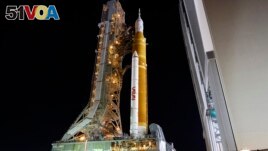The American space agency NASA is making final preparations to launch a new rocket designed to return humans to the moon.
NASA has described its Space Launch System, or SLS, as the most powerful rocket ever built. The 98-meter rocket arrived Wednesday at a launch complex at NASA's Kennedy Space Center in Florida. It took nearly 10 hours for the rocket to make the six-and-a-half kilometer trip to the launch center.
NASA is calling the first launch of the SLS rocket Artemis 1. There will be no crew on the spacecraft during the first mission. SLS will carry NASA's Orion spacecraft on a test mission to fly around the moon.

The NASA Artemis rocket with the Orion spacecraft aboard leaves the Vehicle Assembly Building moving slowly to pad 39B at the Kennedy Space Center in Cape Canaveral, Fla., Tuesday, Aug. 16, 2022. (AP Photo/Terry Renna)
SLS is the first rocket designed to carry both astronauts and supplies on a single mission. It is part of NASA's Artemis program, which aims to land the first woman and first person of color on the moon.
Artemis has a goal to land American astronauts on the moon no earlier than 2025. It would be the first moon landing by astronauts since NASA's Apollo 17 mission in 1972.
Currently, NASA is planning for an August 29 liftoff. Three mannequins will be placed inside the crew capsule at the top of the rocket. They will be connected to a series of sensors designed to measure radiation and movements during the mission.
During the test mission, Orion will aim to travel 450,600 kilometers from Earth, and thousands of kilometers beyond the moon. NASA said this will be farther than any spacecraft built for humans has ever traveled. The mission is expected to last four to six weeks.
The main purpose of the SLS mission is to test the system for a future flight including astronauts. But the rocket will also be carrying a series of payloads to support science experiments.
Among the payloads will be a CubeSat designed to look for water on the moon's surface. CubeSats are small research spacecraft also known as nanosatellites. They provide a low-cost way for scientists, governments and private organizations to carry out space experiments.
NASA calls the CubeSat aboard the SLS Lunar IceCube. It is about the size of a shoe box and weighs 14 kilograms.
While orbiting the moon, Lunar IceCube will use an instrument called a spectrometer to look for and examine lunar ice. A spectrometer is an instrument used to measure atomic and molecular reactions.
NASA has said the search for ice on the moon is important because water is a necessary resource for future exploration activities. Astronauts could use the ice for drinking water and to cool equipment or make rocket fuel for missions deeper into the solar system.
The space agency said in a recent statement that Lunar IceCube will be seeking data on the absorption and release of water from the regolith: the moon's rocky and dusty surface. "With Lunar IceCube investigating this process, NASA can map these changes as they occur on the Moon," the statement said.
The CubeSat will also study the exosphere. The exosphere is the thin, outer area around a planet or satellite object, such as the moon.
NASA says data collected by Lunar IceCube will give scientists a better understanding of how water and other substances behave on the moon. With this information, researchers hope to be able to predict seasonal changes affecting lunar ice that could affect its use as a resource.
I'm Bryan Lynn.
Bryan Lynn wrote this story for VOA Learning English, based on reports from NASA, The Associated Press and Reuters.
______________________________________________________________
Words in This Story
mission – n. a flight by an aircraft or spacecraft to perform a specific task
mannequin – n. an artificial human form
payload – n. the load carried by a vehicle
absorb – v. to take in or soak up something, such as water
occur – v. to happen
